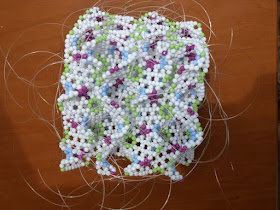
Tuesday, September 27, 2011
Beadworks on display
I have many beadworks made by Chern, Wei-Chi and me on display in the faculty lounge here at the chem dept of NTU.


Monday, September 26, 2011
P, D, and G triply periodic minimal surfaces
A single helical strip
As I discussed in the previous posts, following Chern's construction scheme, I used 16 helical strips to build the overall 2x2x2 gyroical graphitic structure. Each strip contains 8 eight-bead loops, four with blue color and four with purple color as shown in the following photos.

It is interesting note that one can easily create a kink in this helical strip on purpose. A kink in a helix changes the handedness from left to right.


It is interesting note that one can easily create a kink in this helical strip on purpose. A kink in a helix changes the handedness from left to right.

Sunday, September 25, 2011
Saturday, September 24, 2011
Gyroidal graphitic structure (2x2x2)
Chern and I have tried to construct this model for more than four years. I have basically made it today. But I may still need to clean all loose ends up. With a rough estimation, about 4500 beads and 100 fishing threads are used. Sixteen long threads (about 3.5 meter long for each strip) are used for making helical strips, and the remaining short threads are used to connect these strips. We can still see many threads in these photos. My wife made an interesting comment that this is really "千頭萬緒" (thousands of strands and loose ends, meaning very complicated) in a tradition chinese phrase.


The following two pictures are taken on my airport extreme.




The following two pictures are taken on my airport extreme.


Sunday, September 18, 2011
Gyroidal graphitic structure (2x2x1)
Friday, September 16, 2011
Two unit cells of gyroidal graphitic surface (2x1x1)
I found that it is still difficult to identify unambiguously the boundary of gyroidal graphitic structure (GGS) if I don't pay attention to each unit cell carefully from the beginning. So I decided to use the original strategy Chern used to build this structure with helical strips. The photos below show a structure consisting of two unit cells.


In the following photo, I show part of the gyroidal structure that contains only two helical strips. It is interesting to note that one helical strip is right handed and the other one is left handed. But this two-strip unit is still chiral because one of these two strips has to be shifted a half pitch w.r.t. the other strip in order to join them together.



In the following photo, I show part of the gyroidal structure that contains only two helical strips. It is interesting to note that one helical strip is right handed and the other one is left handed. But this two-strip unit is still chiral because one of these two strips has to be shifted a half pitch w.r.t. the other strip in order to join them together.

Monday, September 12, 2011
Sunday, September 11, 2011
Bead model of the longest EMAC
Qian-Rui made this bead model of the longest EMAC (Extended Metal Atom Chain) for Prof. J. McGrady (Univ. of Oxford) who is an expert on the electronic structures of this class of molecules and is going to visit our department today. In making this model, Qian-Rui chose 10mm beads for both metal-metal and metal-ligand bonds, and 8mm beads for chemical bonds of surrounding ligands. The pitch of the surrounding ligands is slightly larger than the true molecular structure of this molecule. Only a single nylon cord with about 7 meter long is used for this model.


Here is a photo for the giant structure of this molecule hung in the main lobby of our department.



Here is a photo for the giant structure of this molecule hung in the main lobby of our department.







